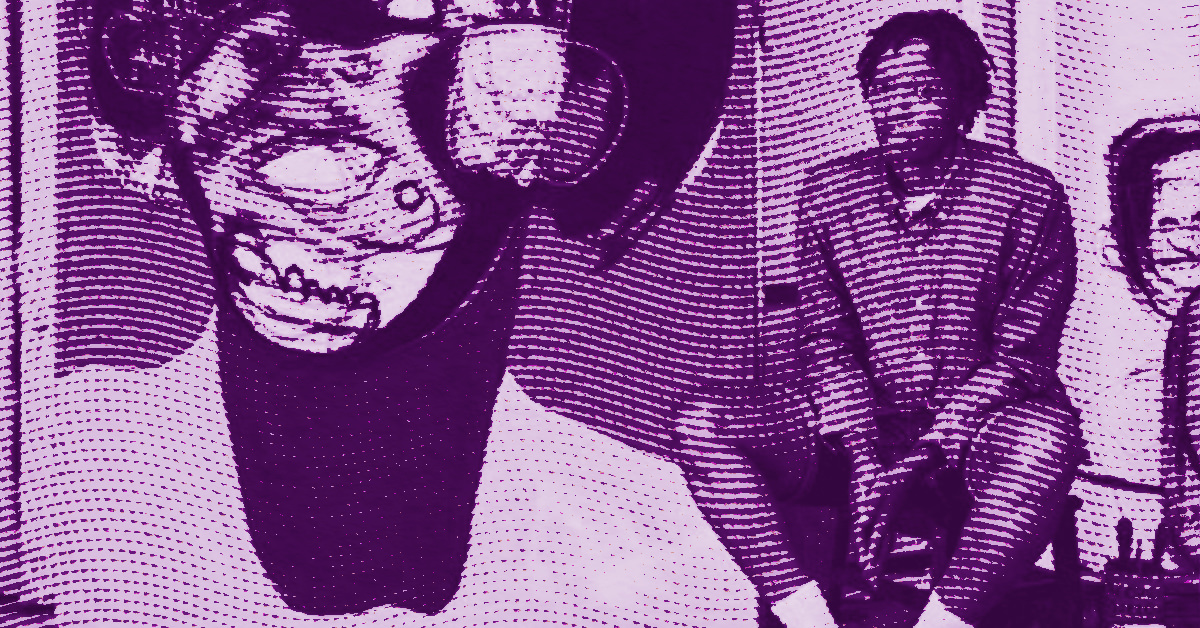Listen to me carefully, you bunch of snobs: Genesis Tramaine paints saints who have nothing to do with your sacristy chromolithographs. This woman from Brooklyn, born in 1983, transforms each canvas into a portable altar, each brushstroke into an act of faith. Her devotional portraits resemble nothing you may have seen in your museums, and that is precisely why they matter.
Tramaine’s art fits within an approach that could be called spiritual neo-expressionism. Her black faces, distorted by ecstasy and suffering, emerge from monochrome backgrounds vibrating with earthly energy. In Joy Comes In The Morning (2020), an oval face overlaps itself in a dance of multiple expressions, while the word “amen” is discreetly inscribed in a corner of the canvas. This multiplication of facial features, eyes, mouths, and noses multiplying, evokes as much mystical visions as cubist techniques of fragmenting reality.
The legacy of American outsider art
It would be tempting to draw a parallel between Tramaine’s work and that of Jean-Michel Basquiat, and this comparison is not accidental. Like her predecessor, she draws from the New York graffiti aesthetic of the 1980s, that period when Brooklyn’s walls became the supports of urgent and authentic artistic expression [1]. But where Basquiat questioned the codes of consumer society and systemic racism, Tramaine surpasses them to reach a truly mystical dimension.
Outsider art, as defined by Jean Dubuffet, is completely freed from academic conventions to embody pure expression, uncorrupted by established cultural codes. Tramaine fits perfectly within this lineage, but with a specificity: her “outsider” is not that of the Freudian unconscious, but that of divine revelation. Her paintings are born from what she calls visions received in prayer, “blueprints of my prayers” that guide her hand toward unexpected forms.
This approach recalls the practices of American visionary painters such as Sister Gertrude Morgan, whom Tramaine cites as a major influence. Morgan also painted under divine inspiration, creating works of striking expressive power. But Tramaine pushes this tradition further by enriching it with a contemporary plastic vocabulary. Her large-scale canvases (often 180 x 180 cm) impose a physical presence that transforms the experience of contemplation into a true spiritual encounter.
Tramaine’s technique mixes acrylic, gouache, oil sticks, and oil pastel, but she adds to this list some rather unexpected elements: Lawry’s salt, rainwater, and especially “Holy Spirit” and “Yahweh,” which she explicitly includes in the list of components of her works. This approach, far from anecdotal, reveals a conception of art as divine collaboration. The artist does not create ex nihilo; she becomes a medium, a channel of an energy that surpasses her.
Theater and performance: painting as liturgy
Tramaine’s work can only be fully understood in connection with the performing arts, and more particularly with the African-American theatrical tradition. Her characters, frozen in their frames, nevertheless seem animated by an inner movement that evokes as much religious trances as gospel performances [2].
In Bearer of Good News (2020), the central figure occupies almost the entire canvas space, like an actor standing before their audience. The sharp yellow, black, and blue features composing this character recall expressionist masks, but also ritual body paintings. Tramaine explains that this work pays tribute to the energy of young black girls, often suppressed by society. By painting, she gives them back a voice, transforming her canvas into a stage where muffled voices can be expressed.
This performative dimension is also found in the creative process itself. Tramaine often paints on the floor, kneeling, in a posture that evokes as much prayer as dance. She listens to contemporary gospel music while working, literally inscribing the musical rhythm into her pictorial gestures. This approach recalls the practices of certain abstract expressionists like Jackson Pollock, but with an explicit spiritual dimension absent from the latter.
African-American theatre, from the minstrel shows subverted by black artists to contemporary creations, has always had the ability to transform the stage into a space of resistance and identity affirmation. Tramaine’s characters inherit this tradition: they are not mere portraits but incarnations of black sanctity that claim their place in an artistic pantheon long dominated by Eurocentric representations.
The artist herself claims this subversive dimension when she declares wanting to “dismantle the patriarchal gaze on religious art.” Her saints with distorted faces, multiple eyes, and gaping mouths challenge traditional iconographic conventions. In Saint Bathsheba (2020), the female figure wears an expression both painful and ecstatic that evokes both Bacon and African ritual masks.
A queer and inclusive spirituality
Tramaine’s position as a black and queer woman in the Southern Baptist Church adds an undeniable political dimension to her work. Her 2018 exhibition titled “God Is Trans” left no doubt about her intentions: to reinvent Christian iconography to include marginalized bodies and identities.
This approach is part of a larger movement of LGBTQ+ communities reclaiming religious symbols. But Tramaine goes beyond simple identity claim. Her saints transcend categories of gender and race to achieve a universal humanity. In Fighting Demons (2020), the raised hand in a gesture of blessing can be read as much as a sign of protection as of resistance.
The artist fully embraces her Christian faith, which constitutes a unique position in the contemporary art world, generally wary of explicit religious expressions. But this faith is neither naive nor doctrinal. It is nourished by a critical and personal reading of the Scriptures, enriched by the lived experience of a woman who had to fight to have her place recognized within the Church.
A new iconography for the 21st century
Tramaine’s most significant contribution undoubtedly lies in her ability to create an authentically contemporary Christian iconography. Her saints do not copy past models; they invent new forms of sanctity adapted to our era.
In David and Goliath (2020), the traditional biblical scene transforms into a meditation on violence and redemption. The gesture of David holding up Goliath’s head can also be read as an outstretched hand toward the defeated enemy, suggesting that true victory lies in compassion rather than destruction.
This reinterpretation of biblical narratives reveals a sophisticated understanding of contemporary theological issues. Tramaine does not simply illustrate the Scriptures; she updates them, making them relevant for a generation seeking meaning in a fragmented world.
Her colors, earthy ochres, deep blues, and bright yellows, evoke both the landscapes of the ancient Near East and the sunsets of Brooklyn. This geographic and temporal synthesis makes her canvases spaces of encounter between past and present, tradition and innovation.
Art as ministry
Tramaine defines herself as a “devotional painter,” a term worth considering. In the Christian tradition, devotion denotes a regular spiritual practice, a faith exercise that engages the whole being. By adopting this term, the artist situates her pictorial practice in a logic of divine service.
This conception of art as ministry radically transforms the status of the artwork. Her paintings are no longer objects of aesthetic contemplation but instruments of spiritual transformation. They invite the viewer to an experience that goes beyond mere visual pleasure to touch on fundamental existential questions.
In Singer of Psalm (2020), the character’s multiple open mouths evoke a choir on their own, turning the individual portrait into a collective celebration. This multiplication of facial elements, recurring in Tramaine’s work, can be read as a metaphor for the ecclesial community: we are all one in Christ, yet each retains her specificity.
The inscription of texts on the edges of her canvases, psalms, spiritual affirmations, and personal messages, reinforces this liturgical dimension. These words, invisible from the front, are revealed only to viewers who take the time to walk around the artwork, creating a form of pictorial pilgrimage.
A novel pictorial language
What stands out in the recent evolution of Tramaine’s work is her ability to invent a pictorial language that is uniquely hers while drawing from various traditions. Her latest canvases, presented in the exhibition “Sweet Jesus!” (2024), mark a significant development: the mouths of her characters open to reveal rows of multiple teeth that evoke both laughter and a scream.
This formal transformation reflects a spiritual maturation. Where her earlier saints seemed to bear the weight of the world on their shoulders, the new ones appear ready to speak, to testify to their faith with communicative joy. In Saint Sarai (2024), the expressive features suggest a woman who has important things to say and carries the wisdom of the ages within her.
This stylistic evolution is accompanied by a deep reflection on the role of art in contemporary society. Tramaine does not paint only for herself or her faith community; she seeks to create a “future language” that can reach generations to come. Her canvases thus become testimonies for the future, messages of hope cast into a world seeking meaning.
Toward an aesthetic of grace
The work of Genesis Tramaine confronts us with a disturbing truth: contemporary art has largely abandoned the spiritual dimension in favor of often sterile intellectualism. By unabashedly expressing her faith, making her artistic practice an act of devotion, she opens unexplored paths and restores to art its primary function: to touch the human soul at its deepest.
Her distorted saints, vibrant colors, and compositions bursting with energy remind us that art can still transform, uplift, and console. In a world saturated with images, her paintings create a space of silence and reflection sorely lacking in our time.
Tramaine does not revolutionize contemporary art; she regenerates it by infusing an authentic spiritual dimension. Her canvases are invitations to step out of our aesthetic certainties and allow ourselves to be surprised by grace. And perhaps that is the most beautiful gift an artist can give us: to remind us that art, beyond all critical discourse, remains above all a matter of faith.
- Cooper, Martha. Subway Art. Thames & Hudson, 1984.
- Johnson, James Weldon. God’s Trombones: Seven Negro Sermons in Verse. Viking Press, 1927.
















